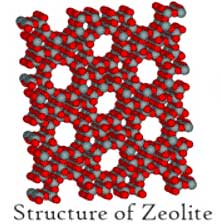Zeolite is a hydrous aluminosilicate mineral containing metal ions such as Na and Ca. Engineers found more and more different structures of natural zeolites and the origin of zeolite in natural minerals and catalysts
Different Structures of Natural Zeolites and Synthetic Zeolites

The content of Na, Ca, Al, and Si elements in the earth’s crust are very rich, and they are all the main rock-forming elements, so zeolite should be a relatively common and widely distributed rock-forming mineral.
After the magma process, the magma is dominated by SiO4 at first due to the high temperature. It is a weak acid and cannot be combined with the strongly alkaline cations K+ and Na+, but can be combined with the alkaline earth metal family of Mg2+ and Fe2+.
The earliest formed rocks are olivine composed of Mgsio4 and Fesic4 and pyroxene composed of Mgsio3 and Fesic3. As the temperature gradually decreases, Si4OR1 and Si2O- species appear. Due to the increased acidity, it combines with the more alkaline K+a+ and Ca2+ to form amphibole and mica. When aluminosilicate appears in magma, it is a strong acid that combines with alkali metal K+, Na+ and alkaline earth metal Ca ions to form various feldspars. Therefore, there is almost no zeolite in the magnetization stage.
In the hydrothermal stage, as the hydrothermal fluid migrates and interacts with the surrounding rock, the hydrothermal fluid gradually changes from acidic to weakly alkaline, and weakly alkaline conditions are conducive to the formation of zeolite.
We know that the crystallization order of minerals is in the order of decreasing lattice energy. For silicate minerals, island-like structural silicates are formed first, followed by chain-like and layered structural silicates, and lastly, framework-like structural silicates. Finally, Few zeolites are formed in the low-temperature hydrothermal stage.
Since the mineralization of zeolite is restricted by the permeability of the rock, the mineralization is more favorable only in the areas where the rock cavities and fissures are relatively developed. This causes the uneven distribution of zeolite minerals in the rock. Although the physical and chemical environment of zeolite ore is very different under the conditions of the development of rock cavities and fissures, the zeolite ore generated under hydrothermal conditions is not conducive to industrial production.
Most of the zeolite composition is formed by the reaction of deposited aluminosilicate minerals with pore water. (Or formed by hydrothermal alteration of aluminosilicate minerals). Due to the uniform texture of the original rock and the relatively stable physical and chemical conditions for mineralization, zeolite formation is slow during diagenesis, so important industrial deposits can be formed.
The origin of zeolite is related to the following factors
The composition, grain size, and permeability of the host rock. Pyroclastic volcanic glass rock (such as perlite, etc.) is the most favorable host rock for the formation of zeolite. These rocks are rich in SiO2, Al2O3, and a certain amount of CaO, Na2O, and other components, which provide the necessary material basis for the formation of zeolite. In addition, these rocks also have special structures and developed cavities and fissures, which provide good conditions for the circulation of pore water.
For example, rhyolite tuff and dacite tuff mainly form high-silica zeolite–clinoptilolite, mordenite, etc.; manganese tuff mainly forms low-silica zeolite- -phillipsite, stilbite, analcime, etc.The Orange vitreous tuff is related to faujasite, analcime, stilbite, and mordenite. Plagioclase-bearing sandstone and stony volcanic sandstone are related to laumontite and heulandite. It can be seen from the above that high-silica zeolites with high alkali content are mainly produced in acidic rocks, while low-silica zeolites occur in basic rocks with low SiO2 content.
The pH value of the pore water Sufficient pore water is the basic factor to hydrate the aluminosilicate to form zeolite, and the pH value of the aqueous solution has a decisive influence on the formation of zeolite. If the pH value is too low, kaolinite may be formed; if the pH value is too high, layered silicate may be formed. Only a proper pH value (9~11) is conducive to zeolite formation. Studies have shown that volcanic glass does not change within a million years under the condition of pH=7.5-8.1, and under alkaline conditions, that is, at pH=9.1-9.9, volcanic glass can form zeolite for tens of thousands of years.
This shows that proper pH and salinity are conducive to the rapid formation of zeolite in volcanic glass.
Temperature and pressure zeolite are water-containing minerals and are susceptible to temperature and pressure. It is generally believed that the zeolite is formed at low temperature and low pressure, but the low temperature and low-pressure conditions can also generate the peeling stone. The benefit of zeolite formation is achieved only at the proper temperature. The results show that 100 – 250℃ favor zeolite formation. From the conditions of synthetic zeolite, the temperature of 100 – 180℃ and 980kPa pressure are generally favorable.
The partial pressure of CO2 is also an important control factor over the stability of zeolite. Being too high reduces the activity of H2O and hinders the formation of zeolite; sufficient CO2 promotes the formation of calcite and is unfavorable to the formation of zeolite. Under the condition of increased temperature and pressure, the zeolite with less water, and large density (such as turbid zeolite, zeolite) contains more water. Many and small densities of zeolite (Such as diamond zeolite, sheet zeolite) is stable. When the sediment burial temperature rises to 150℃, the zeolite is replaced by feldspar.
The basic cation and the active metal cation of silicon, the chemical activity of silicon oxide, and water have an influence on the type of zeolite crystallized from the solution. The high pH value will promote the formation of the high content of cationic zeolite. If there are hydrogen ions in the solution, the hydrogen ions can compete with exchangeable cations. According to the number of competing ions, a framework structure silicate (ie, zeolite) or a layered structure silicate (such as clay minerals) are formed.
In addition, the ratio of cation activity also affects the type of zeolite. The ratio of Ca2+ activity to Na+ activity is high, and the possibility of forming clinique zeolite is greater than that of analcite zeolite, and the possibility of forming mordenite is greater than that of heulandite, and the possibility of forming heulandite zeolite is greater than that of chabazite; K+ activity and Ca2+ activity The ratio is high, and the possibility of forming phillipsite is greater than chabazite.
The distribution of the buried-depth zeolite has a distinct vertical ribbon. Less dense hydrates tend to be close to the surface and with increasing depth the zeolite gradually phases into anhydrous frame aluminum silicate minerals (such as feldspar).
The zeolite deposit in northern Kyushu, Japan, can be divided into four zones downward from the surface.
depth 0.9~2.0km is oblique zeolite, filament zeolite, and quartz bands.
depth 2.0~2.8km is a sheet zeolite, zeolite, quartz calcium feldspar, and potassium feldspar zone.
depth 2.8~3.0km are laumonite zeolite, quartz sodium feldspar, chlorite, chlorite, and potassium feldspar bands.
depth 3.0~5.0km is composed of quartz sodium feldspar, dolomite, chlorite, and potassium feldspar bands. This zonation is generally considered to be related to various factors such as geothermal gradient, solid pressure, the chemical gradient of the crack solution, and the mineral composition of the rock.
In addition, according to the current output of zeolite, it is also believed that the distribution of zeolite is related to the geological age. At present, most of the zeolite deposits known in the world are formed in the Mesozoic to Cenozoic. For example, phillipsite, clinoptilolite, erionite, mordenite, and chabazite are more common in Cenozoic rock formations than pre-Cenozoic rock formations. The abundance of these zeolites decreases with the age of Mesozoic to Paleozoic rocks.
Reference:
